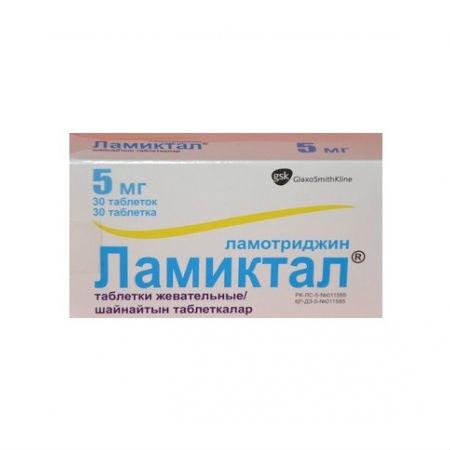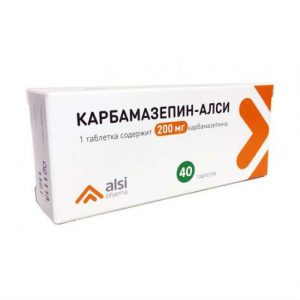Description
Latin name
LAMICTAL
Release form
Chewable / soluble tablets, white or almost white, with the smell of black currant, elongated, biconvex, with GS GS2 stamped on one side and 5 on the other, small blotches may be noted.
packaging 10 pcs – blisters (3) – packs of cardboard.
Pharmacological action
Antiepileptic drug. Lamotrigine is a voltage-gated sodium channel blocker.
In a neuronal culture, it causes a voltage-dependent blockade of continuously repeating impulses and suppresses the pathological release of glutamic acid (an amino acid that plays a key role in the development of epileptic seizures), and also inhibits glutamate-induced depolarization.
Lamictal’s effectiveness in preventing mood disorders in patients with bipolar disorders has been demonstrated in two basic clinical studies. As a result of a combined analysis of the results, it was found that the duration of remission, defined as the time before the first episode of depression and before the first episode of mania / hypomania / mixed after stabilization, was longer in the lamotrigine group compared with placebo.
Duration of remission is more pronounced for depression.
Indications
Epilepsy
for adults and children over 12 years old
– epilepsy (partial and generalized seizures, including tonic-clonic seizures, as well as seizures with Lennox-Gastaut syndrome) as part of combination therapy or monotherapy.
for children 2 to 12 years old
– epilepsy (partial and generalized seizures, including tonic-clonic seizures, as well as seizures with Lennox-Gastaut syndrome) as part of combination therapy (after achieving control of epilepsy in combination therapy, concomitant antiepileptic drugs can be canceled and lamotrigine can be continued in monotherapy)
– monotherapy of typical absences.
Bipolar Disorders
for adults (18 years of age and older)
– to prevent mood disorders (depessia, mania, hypomania, mixed episodes).
Composition
1 tablet lamotrigine * 5 mg
Excipients:
calcium carbonate, low-substituted hydroxypropyl cellulose,
aluminum-magnesium silicate,
sodium starch glycolate (type A), srdlcp AP 0551,
magnesium stearate.
* The non-proprietary international name recommended by WHO is lamotrigine.
Dosage and administration
Epilepsy
Adults and children over 12 years of age with 1 mg of the first dose for 1 mg for 1 week of 1 week of 1 mg for 1 week increasing the dose to 50 mg 1 time / day for the next 2 weeks. Then the dose should be increased by 50-100 mg every 1-2 weeks until the optimal therapeutic effect is achieved. The standard maintenance dose to maintain the optimal therapeutic effect is 100-200 mg / day in 1-2 doses. To achieve a therapeutic effect, some patients require the appointment of Lamiktal at a dose of 500 mg / day.
As part of combination therapy with the combined use of Lamiktal with valproic acid preparations in combination with other antiepileptic drugs (PEP) or without them, the initial dose of Lamiktal is 25 mg every other day for the first 2 weeks thereafter – 25 mg 1 time / day for next 2 weeks. Then the dose should be increased by a maximum of 25-50 mg / day every 1-2 weeks until the optimal therapeutic effect is achieved. The standard maintenance dose to maintain the optimal therapeutic effect is 100-200 mg / day in 1-2 doses.
As part of combination therapy with concomitant therapy with PEP or other drugs that induce glucuronidization of lamotrigine (phenytoin, carbamazepine, phenobarbital and primidone), with or without other probes (with the exception of valproic acid preparations), the initial dose of Lamiktal is 50 mg 1 time / day for the first 2 weeks, then for the next 2 weeks – 100 mg / day in 2 divided doses. Then the dose is increased by 100 mg every 1-2 weeks until the optimal therapeutic effect is achieved. The standard maintenance dose is 200-400 mg / day in 2 divided doses. Some patients may require a dose of 700 mg / day to achieve a therapeutic effect.
As part of combination therapy with oxcarbazepine in combination with any other inducers or inhibitors of lamotrigine glucuronidation or without them, the initial dose of Lamiktal is 25 mg 1 time / day for the first 2 weeks, then 50 mg / day in 1 dose for next 2 weeks. Then the dose is increased by a maximum of 50-100 mg every 1-2 weeks until the optimal therapeutic effect is achieved. The standard maintenance dose is 100-200 mg per day in 1 or 2 doses.
Due to the risk of developing a rash, you should not exceed the initial dose of the drug and the recommended dosage increase regimen.
Children aged 2 to 12 years old
It should be noted that the exact conduct of initial therapy with Lamiktal in 5 mg tablets according to the proposed dosage regimen is not possible if the body weight of the child is less than 17 kg. Most likely, children aged 2 to 6 years will require the highest maintenance dose.
The initial dose of Lamiktal for monotherapy of typical absences is 0.3 mg / kg body weight / day in 1 or 2 doses for the first 2 weeks with a subsequent increase in dose to 0. 6 mg / kg / day in 1 or 2 doses over the next 2 weeks. Then the dose should be increased to a maximum of 0.6 mg / kg every 1-2 weeks until an optimal therapeutic effect is achieved. The usual maintenance dose to achieve the optimal therapeutic effect is from 1 to 10 mg / kg / day in 1 or 2 doses, although some patients with typical absences require higher doses to achieve the therapeutic effect.
As part of combination therapy when applying Lamiktal with valproic acid preparations in combination with or without other probes, the initial dose of Lamiktal is 0.15 mg / kg body weight 1 time / day for the first 2 weeks, in the future – 0.3 mg / kg 1 time / days over the next 2 weeks. Then the dose should be increased by 0.3 mg / kg every 1-2 weeks, until the optimal therapeutic effect is achieved. The standard maintenance dose in this case is 1-5 mg / kg / day in 1-2 doses. The maximum daily dose is 200 mg.
As part of combination therapy with concomitant therapy with PEP or other drugs that induce lamotrigine glucuronidation (phenytoin, carbamazepine, phenobarbital and primidone), in combination with other PEPs or without them (with the exception of valproic acid preparations), the initial dose of Lamictal is 0.6 mg / kg / day in 2 divided doses during the first 2 weeks, in the future – 1.2 mg / kg / day in 2 divided doses over the next 2 weeks. Then the dose should be increased by a maximum of 1.2 mg / kg / day every 1-2 weeks until the optimal therapeutic effect is achieved. Standard maintenance dose at which the maximum therapeutic effect is achieved is 5-15 mg / kg / day in 2 divided doses. The maximum daily dose is 400 mg.
As part of combination therapy with oxcarbazepine without any other inducers or inhibitors of lamotrigine glucuronidation, the initial dose of Lamiktal is 0.3 mg / kg body weight 1 or 2 times / day for the first 2 weeks, then 0.6 mg / kg / day in 1 or 2 doses over the next 2 weeks. Then the dose is increased by a maximum of 0.6 mg / kg every 1-2 weeks until the optimal therapeutic effect is achieved. The standard maintenance dose is 1-10 mg / kg / day in 1 or 2 doses. The maximum dose is 200 mg / day.
To ensure that a therapeutic dose is maintained, it is necessary to control the body weight of the child and adjust the dose of the drug when it changes.
Due to the risk of developing a rash, you should not exceed the initial dose of the drug and the recommended dosage increase regimen.
There is insufficient information on the use of Lamictal in children under 2 years of age.
When canceling concomitant antiepileptic drugs to switch to Lamiktal monotherapy or when prescribing other drugs or PEP while taking Lamiktal, it should be taken into account that this may affect the pharmacokinetics of lamotrigine.
Bipolar Disorders
Adult patients over 18 years of age
Due to the risk of developing a rash, the initial dose of the drug and the subsequent dosage increase regimen should not be exceeded.
Follow the transitional dosing schedule, which includes an increase over a 6-week dose of lamotrigine to a maintenance stabilizing dose, after which, if indicated, other psychotropic and / or antiepileptic drugs can be canceled.
The maintenance stabilizing dose varies depending on the clinical effect.
As part of combination therapy with the combined use of Lamictal and other PEPs that inhibit hepatic enzymes (for example, with valproic acid preparations), Lamictal is prescribed at a dose of 25 mg every other day, then 25 mg 1 time / day for the next 2 weeks, at 5 weeks, the dose should be increased to 50 mg / day in 1-2 doses. The stabilizing dose at week 6 is 100 mg / day in 1 2 doses, however, it can be increased to a maximum daily dose of 200 mg, depending on the clinical effect.
As part of combination therapy with the combined use of Lamictal and other PEP inducing liver enzymes (for example, carbamazepine, phenobarbital), in patients not receiving valproic acid preparations, Lamictal is prescribed at a dose of 50 mg 1 time / day for the first 2 weeks, 3-4 weeks – 100 mg / day in 2 divided doses, at 5 weeks – 200 mg / day in 2 divided doses. At week 6, the dose can be increased to 300 mg / day, however, the stabilizing dose to achieve the optimal therapeutic effect is 400 mg / day in 2 divided doses, and is prescribed starting from week 7.
With monotherapy with Lamiktal or as part of combination therapy with the combined use of Lamiktal with lithium preparations, bupropion, olanzapine, oxcarbazepine, without the use of inducers or inhibitors of glucuronidation of lamotrigine for the first 2 weeks, Lamictal is prescribed at a dose of 25 mg 1 time / day, at 3-4 weeks – 50 mg / day in 1-2 doses, at 5 weeks – 100 mg / day in 1- 2 receptions. The stabilizing dose at 6 weeks is 200 mg / day in 1-2 doses. However, in clinical trials, doses ranging from 100 to 400 mg were used.
After reaching the daily maintenance stabilizing dose, other psychotropic drugs may be withdrawn.
If necessary, the dose may be increased to 400 mg / day.
After canceling additional therapy with lamotrigine glucuronidation inhibitors (for example, valproic acid preparations), the stabilizing initial dose of lamotrigine doubles and is maintained at this level.
After the abolition of additional therapy with lamotrigine glucuronidation inducers (i.e. including phenytoin, carbamazepine, phenobarbital, primidone) the dose of lamotrigine gradually decreases over 3 weeks, depending on the initial maintenance dose.
After withdrawal of concomitant psychotropic or antiepileptic drugs that do not have significant pharmacokinetic interactions with lamotrigine (for example, lithium, bupropion, olanzapine, oxcarbazepine), the stabilizing dose of Lamictal achieved during the increase regimen should be maintained.
There is no clinical experience with the correction of daily doses of lamotrigine in patients with bipolar disorders after the addition of other drugs.
During clinical trials of Lamiktal in bipolar disorders, a sharp withdrawal of lamotrigine did not cause an increase in the frequency, severity, or change in the nature of adverse reactions compared with placebo. Thus, Lamictal can be canceled immediately, without a gradual dose reduction.
Lamotrigine is not indicated for bipolar disorders in children and adolescents under 18 years of age. The safety and effectiveness of lamotrigine in bipolar disorder in patients of this age group have not been evaluated.
When Lamiktal was prescribed to women already taking hormonal contraceptives, special regimes for increasing lamotrigine doses were not developed (despite the fact that hormonal contraceptives increase lamotrigine clearance). The dose escalation regimen should follow the recommended guidelines, depending on whether lamotrigine is prescribed with valproic acid (a lamotrigine glucuronidation inhibitor) or lamotrigine glucuronidation inducer or lamotrigine is prescribed in the absence of valproic acid or lamotrigine glucuronidation inducers.
When prescribing hormonal contraceptives to patients already taking maintenance doses of Lamictal and not taking lamotrigine glucuronidation inducers, in most cases an increase in the dose of lamotrigine is required, but no more than 2 times. When prescribing hormonal contraceptives, it is recommended to increase the dose of lamotrigine by 50 – 100 mg / day every week, depending on the clinical picture. It is not recommended to exceed these figures if the clinical condition of the patient does not require a further increase in the dose of lamotrigine.
When you stop taking hormonal contraceptives by patients already taking maintenance doses of Lamictal and not taking lamotrigine glucuronidation inducers, in most cases a 2-fold dose reduction of lamotrigine is required. A gradual decrease in the daily dose of lamotrigia by 50-100 mg every week (a decrease of not more than 25% of the daily dose per week) for more than 3 weeks is recommended, depending on the clinical picture.
Despite the fact that with the combined use of atazanavir / ritonavira, the concentration of lamotrigine in plasma decreased, the recommended increase in the dose of lamotrigine while taking atazanavir / ritonavir is not required. An increase in the dose of lamotrigine should be based on recommendations based on whether lamotrigine is added to valproic acid therapy (lamotrigine glucuronidation inhibitor), to lamotrigine glucuronidation therapy, or lamotrigine is used in the absence of valproic acid or lamotrigine glucuronidation inducer.
In patients already taking maintenance doses of lamotrigine and not taking lamotrigine glucuronidation inducers, when prescribing atazanavir / ritonavir, the dose of lamotrigine may need to be increased, and if you discontinue atazanavir / ritonavir, the dose of lamotrigine may need to be reduced.
Correction of the dosing regimen in elderly patients (over 65 years) is not required (because the pharmacokinetics in this age group does not differ from that in adults).
In case of impaired liver function of moderate (class B on the Child-Pugh scale) and severe (class C on the Child-Pugh scale) initial, increasing and maintenance doses should be reduced by approximately 50% and 75%, respectively. Increasing and maintenance doses should be adjusted according to the clinical effect.
In the terminal stage of renal failure, the initial dose of lamotrigine is calculated in accordance with the standard regimen for the administration of an antiepileptic drug. For patients with a significant reduction in renal function, a maintenance dose reduction may be recommended.
Chewable / soluble Lamiktal tablets can be chewed, dissolved in a small volume of water (sufficient to cover the entire tablet), or swallowed whole with a little water.
If the calculated dose of lamotrigine (for example, when given to children or patients with impaired liver function) cannot be divided into a whole number of tablets of a lower dosage, then the patient should be given a dose that corresponds to the nearest value of the whole tablet at a lower dosage.
If you resume taking lamotrigine, your doctor should evaluate the need to increase the maintenance dose in patients who have stopped taking the drug for any reason, since high initial doses and exceeding the recommended doses are associated with the risk of developing a severe rash. The more time has passed since the last administration of the drug, the more carefully the dose should be increased to a maintenance dose. If the time after stopping the intake exceeds 5 elimination half-lives, then the dose of lamotrigine should be increased to the maintenance one according to the corresponding scheme.
Lamotrigine therapy should not be resumed in patients whose discontinuation of lamotrigine treatment was associated with the appearance of a rash, unless the potential benefit of such therapy obviously exceeds the possible risk.
Side effects
The adverse events presented below are listed according to the anatomical and physiological classification and frequency of occurrence. The frequency of occurrence is determined as follows: very often ( 1/10), often ( 1/100, <1/10), infrequently ( 1/1000, <1/100), rarely ( 1/10 000, < 1/1000), very rarely (<1/10 000, including isolated cases). Frequency categories were formed on the basis of clinical studies of the drug and post-marketing observation. In patients with epilepsy From the skin and subcutaneous fat: very often – skin rashes rarely – Stevens-Johnson syndrome, very rarely – toxic epidermal necrolysis. In double-blind clinical trials in adults where lamotrigine was used as a combination therapy, the incidence of skin rash in patients taking lamotrigine was 10%, and in patients taking placebo it was 5%. In 2% of cases, the occurrence of a skin rash caused the withdrawal of lamotrigine. The rash, mainly of a maculopapular nature, usually appears within the first 8 weeks from the start of therapy and disappears after discontinuation of the drug. There are reports of rare cases of the development of severe, potentially life-threatening skin lesions, including Stevens-Johnson syndrome and toxic epidermal necrolysis (Lyell’s syndrome). Although in most cases when the drug was canceled, the symptoms reversed, some patients left irreversible scars, and in rare cases, deaths associated with taking the drug have been reported. The overall risk of developing a rash was largely associated with a high initial dose of lamotrigine and exceeding the recommended rate of increase in doses of lamotrigine, with the concomitant use of valproic acid. The development of the rash was also seen as a manifestation of hypersensitivity syndrome associated with various systemic manifestations. From the hemopoietic organs and lymphatic system: very rarely – hematological disorders (neutropenia, leukopenia, anemia, thrombocytopenia, pancytopenia, aplastic anemia, agranulocytosis), lymphadenopathy. Hematologic disorders and lymphadenopathy may or may not be associated with hypersensitivity syndrome. On the part of the immune system: very rarely – hypersensitivity syndrome (including symptoms such as fever, lymphadenopathy, swelling of the face, disorders of the blood and liver function, DIC, multiple organ failure). The rash is also seen as part of a hypersensitivity syndrome associated with various systemic manifestations, including fever, lymphadenopathy, facial swelling, blood disorders, and liver function. The syndrome occurs with varying degrees of severity and can in rare cases lead to the development of DIC and multiple organ failure. It is important to note that early manifestations of hypersensitivity (i.e., fever, lymphadenopathy) can occur even in the absence of obvious signs of a rash. With the development of such symptoms, the patient should be immediately examined by a doctor and, unless another reason for the development of symptoms is established, lamotrigine should be abolished. From the psyche: often – aggressiveness, irritability very rarely – tics, hallucinations, confusion. From the side of the central nervous system: with monotherapy: very often – headache often – drowsiness, insomnia, dizziness, tremor infrequently – ataxia rarely – nystagmus. As part of combination therapy: very often – drowsiness, ataxia, headache, dizziness often – nystagmus, tremor, insomnia very rarely – aseptic meningitis, agitation, instability of gait, motor disorders, worsening symptoms of Parkinson’s disease, extrapyramidal disorders, choreoathetosis, increased frequency of convulsions seizures. There are reports that lamotrigine may worsen the extrapyramidal symptoms of parkinsonism in patients with concomitant Parkinson’s disease, and in rare cases cause extrapyramidal symptoms and choreathetosis in patients without previous disorders. From the sensory organs: with monotherapy: infrequently – diplopia, blurred vision as part of combination therapy: very often – diplopia, blurred vision rarely – conjunctivitis. From the digestive system: with monotherapy: often – nausea, vomiting, diarrhea as part of combination therapy: very often – nausea, vomiting often – diarrhea very rarely – increased activity of liver enzymes, impaired liver function, liver failure. Violations of liver function usually develop in combination with symptoms of hypersensitivity, but in isolated cases were noted in the absence of obvious signs of hypersensitivity. From the side of muscle and connective tissue: very rarely – lupus-like syndrome. Other: often fatigue In patients with bipolar affective disorder To assess the overall safety profile of lamotrigine, the adverse events listed below should be taken into account along with those characteristic of epilepsy. From the skin and subcutaneous fat: very often – a skin rash is rare – Stevens-Johnson syndrome. When evaluating all studies (controlled and uncontrolled) to study the use of Lamiktal in patients with bipolar affective disorder, a skin rash occurred in 12% of all patients receiving lamotrigine, while the frequency of skin rash only in controlled studies was 8% in patients receiving Lamiktal, and in 6% of patients receiving placebo. From the side of the central nervous system: very often – headache often – agitation, drowsiness, dizziness. From the side of muscle and connective tissue: often – arthralgia. From the digestive system: often – dry oral mucosa. Other: often – pain, back pain. Overdose A single administration of Lamictal at a dose exceeding the maximum therapeutic dose of 10-20 times has been reported. The following symptoms were observed: nystagmus, ataxia, impaired consciousness and coma. Treatment: hospitalization and supportive care are recommended in accordance with the clinical picture or the recommendations of the National Toxicology Center. Storage conditions The drug should be stored in a dry, dark place, out of the reach of children, at a temperature not exceeding 30 ° C. Expiration 3 years. Deystvuyuschee substances Lamotrigine dosage form Dosage form tablets




